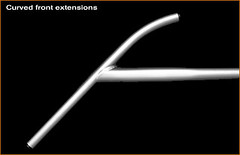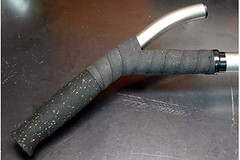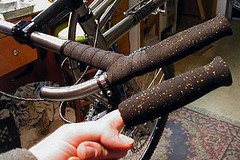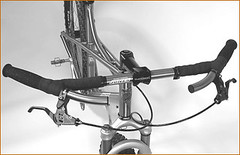Surly 'Pugsley'
A well thoughtout, 'first' dedicated production 'fat bike' frameset:
- relatively inexpensive
- versatile amenities brakes, racks and gearing
- 135mm spacing front and rear, interchangeable
- clearance for large rims and snow tires
- solid construction w/ reasonable overall weight

Pugsley and Surly related Copy
Read from various forums, correspondance, websites.
Compiled here in one archive!
TRIPS
Pat & Kathy's 160 mile bicycle beach ride
from near Hope to Homer,Alaska
Pugsley Canning Stock Route Adventure
Jakub's CSR Pugsley Adventure (from Surly website)
A Report on the 2006 Knik Glacier Expedition
DISCUSSIONS
Surly Pugsley Blog
Sand/snow bike build blog
Pugs on Snow
Pugsley Riding Tips
Pugsley Blog
Pugsley Transport
29er SnoCat offset wheelset for a Pugsley
Pugsley at Tour de Felasco
Need Pugsley Snow Bike Setup Help
Pugsley Pics From Today
Large Marge, Setup Info From Surly Spew
________________________________
SOME PHOTOS OF THE PUGSLEY
http://www.surlybikes.com/surlyblog.html
_________________________________Pugsley setup and spec sheet
From the Surly website:http://www.surlybikes.com/pugsley.html
The premise behind Pugsley’s design is based on the allowance of tires with a larger-than-average footprint. Our frame and fork will accept 4” tires on 26” rims. The floatation and traction gained by using large-volume, low-pressure tires can get you over and through otherwise-unrideable terrain: ice, snow, sand, mud, wet rocks and roots. In many conditions, bigger is better.
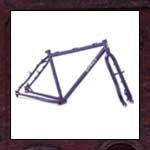
There are design problems associated with using wide tires, however: the tire can rub on the chain, the chainstays, and the front derailleur. We’ve addressed these issues by using a 100mm-wide bottom bracket shell and providing an E-type front derailleur mount. The 100mm shell allows us to widen the chainstays for more tire/frame clearance, and it moves the chainrings outward for more chain/tire clearance. An E-type bottom bracket-mounted front derailleur positions the derailleur cage outboard of the tire. In order to maintain a good chainline with this setup, we offset the rear hub 17.5mm to the drive side...the same distance that the chainrings moved outward (compared to a standard chainline). The result is a straight chainline and the ability to use a standard drivetrain (compact mountain triple crankset with a full cassette of cogs on a 135mm-spaced hub) without chain/tire/front derailleur interference. Pugsley has horizontal drops with a derailleur hanger, so you can set it up as a single-speed or internally-geared rig if you don’t want to use derailleurs.
Note: After lacing up some Pugsley offset wheels, we’ve decided to modify some Large Marge rims to give you more disc-side dish and more even spoke tension. Use these special, asymmetrically-drilled (6mm offset) Large Marge rims on the Pugsley. Non-Surly rims, intended for use in Pugsley wheelsets, should be drilled 6-12mm offset to the drive side.
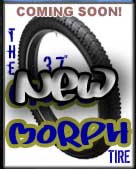
Now, think about trying to shove a 4” (102mm) tire through the dropouts of a fork designed to accept a standard 100mm-wide front hub. Add a disc brake caliper to narrow the gap. It all adds up to a big hassle when trying to get a wheel, with an inflated tire, in and out of the fork. We solved the problem by designing the fork to use a wider hub. Pugsley uses a 135mm hub on the rear, so it seemed logical to use a 135mm hub on the front, too. We offset the fork the same distance as the rear end, so the wheels will be interchangeable. Why would you want interchangeable wheels?
- If you’re using your rig as a single-speed, differently-sized freewheels can be installed on each wheel to give you high and low gear options
- You may want a fixed-gear/freewheel option, in case there is a risk of your freewheel seizing up or not engaging when riding in extreme conditions. A fixed cog always moves you forward. And, it can be used to slow you down, if you choose not to use brakes or if your brakes stop working
- If you use the same model of hub front and rear, you’ll only use 1 or 2 lengths of spokes versus 3 or 4…less confusion and fewer spare spokes to carry if you’re on a remote tour
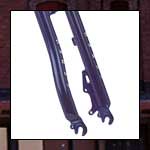
If you decide that you don’t want to use the Pugsley fork, our Instigator fork (as well as many 100mm-travel suspension forks) has the same axle-to-crown length. You’ve got plenty of fork options with this frame.
We provide disc brake tabs on the frame and fork. If you’re using discs, you’ll have to use rear brakes or rear brake adapters for the frame and the fork. Absorb that for a second: rear hub & rear brake on both ends of the bike. Not everybody needs or wants disc brakes, so we also provide 120mm-spaced cantilever pivots for those of you who want to run traditional cantilevers. Keep in mind you’ll need to use our Large Marge rims to use these types of brakes. The pivots are thread-in type, so they’re removable if you don’t want ‘em on there. V-brakes and other types of rim brakes will not work; the tire interferes.
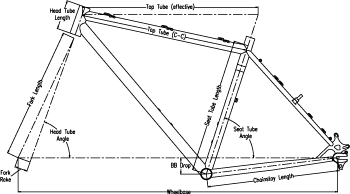
The ride quality of the 1x1 has proven itself over the years, so we decided not to stray too far from the tried and true. Pugsley's geometry is a bit relaxed compared to the 1x1 frame, so the Pugsley is comfortable but still responsive and maneuverable. It handles essentially like a mountain bike, but it is far more stable on and in the slick stuff compared to most bikes. Large-volume tires (we highly recommend the Surly Endomorph 3.7 tires) allow it to float over snow, sand, and mud better than any bike you’ve ridden to date. And, like all our frames, it’s durable, too.
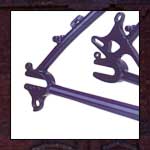
Who should ride Pugsley? Hunters of all types (animal, mineral, or vegetable), beach/desert riders, snow/ice riders, wilderness explorers, and anybody else in need of a bike that will provide extra stability, traction, and floatation when the terrain gets loose and unpredictable. Pugsley was created to go where other bikes may flounder. Who should ride a Pugsley? You should, but you may not realize it yet.
SPECS Pugsley Frameset | |
Tubing: |
|
Rear Dropouts: |
|
Braze compatibility: | Most rear international standard disc brakes or cantilever-type rim brakes (when using Large Marge) |
Braze-ons: | Cantilever bosses with removable pivots, dual water bottle mounts, top tube cable housing guides for use with continuous housing, fender and rack eyelets |
Seatpost : |
|
Seatpost dia: |
|
Headset: |
|
Front deraill: |
|
BB shell: |
|
Chainring clear: |
|
Fork: |
|
Sizes available: | 16", 18", 20" and 22" (measured from the center of the bb to the top of the top tube) |
Color: | Barney Blue/Purple Pearl Sizzurple |
Weight: | 18" medium- 5.66 lb (2.56 kg) |
__________________________________
WILDERNESS TRAIL BIKES
BB PEDALS HUBS HDSET
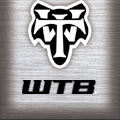
When it comes to winter riding in Alaska the words that come to mind are variable and extreme. Low temps (-20 and below possible), wet conditions (river overflow to your knees), ocean environs (can you say salts)...and they all raise their own havoc on any part that is "bearing'd".
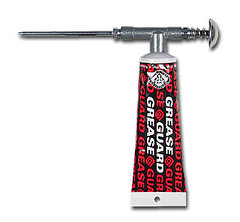
When we built our original 'ice bikes' on the Kobuk River some 20+ years ago the IBIS crew and I envisioned a bike with components that were completely servicable; in situ! WTB was just bring their Grease Guard systems to market and IBIS built the 'Kobuk River Cruisers' / KRC with GG Hubs and retro'd the simple steel headset pedals and BB with the GG concept (other WTB parts were not available yet - but the concepts were well rooted and on the D-board).

When we built our original 'ice bikes' on the Kobuk River some 20+ years ago the IBIS crew and I envisioned a bike with components that were completely servicable; in situ! WTB was just bring their Grease Guard systems to market and IBIS built the 'Kobuk River Cruisers' / KRC with GG Hubs and retro'd the simple steel headset pedals and BB with the GG concept (other WTB parts were not available yet - but the concepts were well rooted and on the D-board).

The key to successful riding in the 'extreme' and the reliability of the product has clearly been the serviceability. Granted, I have been relentless in purging the hubs and I've researched and applied some high-end industrial products (Arctic greases and lubes) but...the hubs just keep on turning - even at 25 below!
WTB products have allowed me to ride where no bikes have gone (in most cases and at least not often if so) with the performance and reliability neccessary for survival in the wilderness and winter environs here in remote Alaska.
For that reason, we are working with WTB to ensure the same performance, reliability and survivability in our new KRC / KISS Quest.
More to come...
________________________________________________
DRIVE TRAIN
AOC is testing some of White Industries 'hardware' for the 'Kuskokwim River Cruiser', spec bikes they're planning on producing.
They have some killer SS products that fit the bill...
http://www.whiteind.com/ENO_web/about.html
From White:
ENO Single Speed Hubs deliver proper chain line on single speed bikes, so we designed the ENO with single speed mountain bikes in mind. We also use stainless steel axle ends with an aluminum axle. The bolt on axle ends are available with an 8mm Allen head and can be converted to QR axle ends.
Single Speed bikes are a fun way to get that child in you to ride! With our ENO line of single speed components, you can choose from standard single speed hubs, dedicated disc brake hubs, and the unabashed and never duplicated Eric's Eccentric ENO fixed gear hub.
We also pride ourselves with the fine craftsmanship of the ENO Trials Freewheel and ENO Crankset.
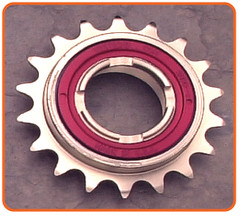
Freewheels !DOS ENOS 'Dually'!
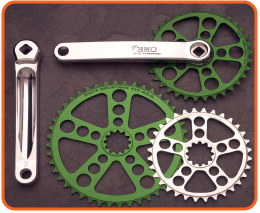
DOS ENOS 'Dually' Cranks
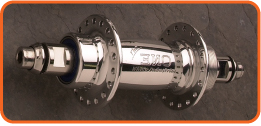
Cranks !Eric's ENO Eccentric!
___________________________________
Jones Bikes' H-Bar
Jeff Jones Custom Bicycles
8000 Griffin Creek Road
Medford, Oregon, 97501
Phone: 541-535-2034 (10am to 5pm Pacific Time M-F)
Email: jeff@jonesbikes.com
